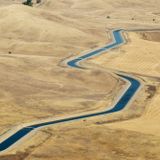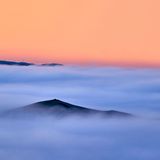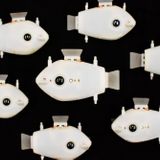RECENT ARTICLES
UC Berkeley Was About to Launch a Satellite. Then PG&E Said It Was Cutting Power
as the workday was winding down, Paula Milano received a phone call that threw her week into chaos. Milano, who helps run the Space Sciences Laboratory at UC Berkeley, had been gearing up for a satellite launch. But on the phone now was a friend of hers, with bad news: PG&E, the power company, the school that its electricity could be cut Wednesday—making the campus one of more than 700,000 customers .The outage was to keep forecasted high winds from jostling electrical equipment and starting . And it fell to this friend, who manages several buildings on campus, to piece together a plan...…as the workday was winding down, Paula Milano received a phone call that threw her week into chaos. Milano, who helps run the Space Sciences Laboratory at UC Berkeley, had been gearing up for a satellite launch. But on the phone now was a friend of hers, with bad news: PG&E, the power company, the school that its electricity could be cut Wednesday—making the campus one of more than 700,000 customers .The outage was to keep forecasted high winds from jostling electrical equipment and starting . And it fell to this friend, who manages several buildings on campus, to piece together a plan...WW…

Narwhal tusks tell a troubling tale
Researchers have long debated what the 10-foot-long tooth that erupts from a narwhal’s head is actually for. Perhaps it has something to do with , and males with longer horns attract more females. Or maybe the things . Or perhaps a narwhal uses its tusk to flush out prey on the ocean bottom.Whatever the purpose, scientists know this for certain: the Arctic region, which the narwhals call home, is warming as the rest of the planet, and by analyzing these tusks, researchers can glean surprisingly detailed insights into how the animals are dealing with catastrophic change. It’s not looking...…Researchers have long debated what the 10-foot-long tooth that erupts from a narwhal’s head is actually for. Perhaps it has something to do with , and males with longer horns attract more females. Or maybe the things . Or perhaps a narwhal uses its tusk to flush out prey on the ocean bottom.Whatever the purpose, scientists know this for certain: the Arctic region, which the narwhals call home, is warming as the rest of the planet, and by analyzing these tusks, researchers can glean surprisingly detailed insights into how the animals are dealing with catastrophic change. It’s not looking...WW…

Nine Russian adventurers mysteriously froze to death—a new theory explains why
By the time the rescue team helicoptered to the remote Dyatlov Pass in late February 1959, the nine Russian adventurers—seven men and two women, all highly experienced cross-country skiers—had been dead for nearly a month. Nothing about the scene seemed right. The adventurers’ tent had been sliced open from the inside, and in its husk lay rucksacks, neatly arranged boots, and a plate of sliced pork fat. The rescuers found the victims themselves over half a mile downslope from their camp, some of them barefoot and almost naked. The primary cause of death was hypothermia—temperatures would...…By the time the rescue team helicoptered to the remote Dyatlov Pass in late February 1959, the nine Russian adventurers—seven men and two women, all highly experienced cross-country skiers—had been dead for nearly a month. Nothing about the scene seemed right. The adventurers’ tent had been sliced open from the inside, and in its husk lay rucksacks, neatly arranged boots, and a plate of sliced pork fat. The rescuers found the victims themselves over half a mile downslope from their camp, some of them barefoot and almost naked. The primary cause of death was hypothermia—temperatures would...WW…

Scientists Accidentally Discover Strange Creatures Under a Half Mile of Ice
View more middle of the Filchner-Ronne Ice Shelf—a five-hour flight from the nearest Antarctic station—nothing comes easy. Even though it was the southern summer, geologist James Smith of the British Antarctic Survey endured nearly three months of freezing temperatures, sleeping in a tent, and eating dehydrated food. The science itself was a hassle: To study the history of the floating shelf, he needed seafloor sediment, which was locked under a half mile of ice.To get to it, Smith and his colleagues had to melt 20 tons of snow to create 20,000 liters of hot water, which they then pumped...…View more middle of the Filchner-Ronne Ice Shelf—a five-hour flight from the nearest Antarctic station—nothing comes easy. Even though it was the southern summer, geologist James Smith of the British Antarctic Survey endured nearly three months of freezing temperatures, sleeping in a tent, and eating dehydrated food. The science itself was a hassle: To study the history of the floating shelf, he needed seafloor sediment, which was locked under a half mile of ice.To get to it, Smith and his colleagues had to melt 20 tons of snow to create 20,000 liters of hot water, which they then pumped...WW…

Scientists Accidentally Discover Strange Creatures Under a Half Mile of Ice
middle of the Filchner-Ronne Ice Shelf—a five-hour flight from the nearest Antarctic station—nothing comes easy. Even though it was the southern summer, geologist James Smith of the British Antarctic Survey endured nearly three months of freezing temperatures, sleeping in a tent, and eating dehydrated food. The science itself was a hassle: To study the history of the floating shelf, he needed seafloor sediment, which was locked under a half mile of ice.To get to it, Smith and his colleagues had to melt 20 tons of snow to create 20,000 liters of hot water, which they then pumped through a...…middle of the Filchner-Ronne Ice Shelf—a five-hour flight from the nearest Antarctic station—nothing comes easy. Even though it was the southern summer, geologist James Smith of the British Antarctic Survey endured nearly three months of freezing temperatures, sleeping in a tent, and eating dehydrated food. The science itself was a hassle: To study the history of the floating shelf, he needed seafloor sediment, which was locked under a half mile of ice.To get to it, Smith and his colleagues had to melt 20 tons of snow to create 20,000 liters of hot water, which they then pumped through a...WW…

American Cities Are Way Underreporting Their Carbon Footprints
you reckon your city contributes to climate change? If you added up the emissions from all the homes, businesses, vehicles, industries—everything that makes a city a city—what would your local carbon footprint be?If you haven’t a clue, you’re not alone. It turns out that city officials themselves are struggling to accurately self-report local emissions, according to out today in the journal Nature Communications. The study used Vulcan, a comprehensive emissions model developed by the researchers, to analyze 48 American cities. It found that, on average, officials are underreporting their...…you reckon your city contributes to climate change? If you added up the emissions from all the homes, businesses, vehicles, industries—everything that makes a city a city—what would your local carbon footprint be?If you haven’t a clue, you’re not alone. It turns out that city officials themselves are struggling to accurately self-report local emissions, according to out today in the journal Nature Communications. The study used Vulcan, a comprehensive emissions model developed by the researchers, to analyze 48 American cities. It found that, on average, officials are underreporting their...WW…

Why Covering Canals With Solar Panels Is a Power Move
jelly. Hall & Oates. Now there’s a duo that could literally and figuratively be even more powerful: solar panels and canals. What if instead of leaving canals open, letting the sun evaporate the water away, we covered them with panels that would both shade the precious liquid and hoover up solar energy? Maybe humanity can .Scientists in California just ran the numbers on what would happen if their state slapped solar panels on 4,000 miles of its canals, including the major California Aqueduct, and the results point to a potentially beautiful partnership. Their feasibility , published in...…jelly. Hall & Oates. Now there’s a duo that could literally and figuratively be even more powerful: solar panels and canals. What if instead of leaving canals open, letting the sun evaporate the water away, we covered them with panels that would both shade the precious liquid and hoover up solar energy? Maybe humanity can .Scientists in California just ran the numbers on what would happen if their state slapped solar panels on 4,000 miles of its canals, including the major California Aqueduct, and the results point to a potentially beautiful partnership. Their feasibility , published in...WW…

Is It Time for an Emergency Rollout of Carbon-Eating Machines?
View more demands that we dramatically and rapidly cut emissions. There’s no substitute for that, full stop. But it also demands a technological revolution to reverse years of out-of-control emissions: The UN’s Intergovernmental Panel on Climate Change notes that if we want to meet most optimistic goal of limiting warming to 1.5 degrees Celsius above preindustrial levels, deploy some sort of negative emissions technologies.One promising technique is known as direct air capture (DAC), machines that scrub the atmosphere of CO2. Early versions of these facilities already exist: One firm called...…View more demands that we dramatically and rapidly cut emissions. There’s no substitute for that, full stop. But it also demands a technological revolution to reverse years of out-of-control emissions: The UN’s Intergovernmental Panel on Climate Change notes that if we want to meet most optimistic goal of limiting warming to 1.5 degrees Celsius above preindustrial levels, deploy some sort of negative emissions technologies.One promising technique is known as direct air capture (DAC), machines that scrub the atmosphere of CO2. Early versions of these facilities already exist: One firm called...WW…

Adorable Fish Bots Get Schooled in How to Swarm
gently swim around a darkened tank in a Harvard University lab, spying on one another with great big eyes made of cameras. They’re on the lookout for the two glowing blue LEDs fixed to the backs and bellies of their comrades, allowing the machines to lock on to one another and form schools, a complex emergent behavior arising from surprisingly simple algorithms. With very little prodding from their human engineers, the seven robots eventually arrange themselves in a swirling tornado, a common defensive maneuver among real-life fish called milling.Bluebot is the latest entry in a field known...…gently swim around a darkened tank in a Harvard University lab, spying on one another with great big eyes made of cameras. They’re on the lookout for the two glowing blue LEDs fixed to the backs and bellies of their comrades, allowing the machines to lock on to one another and form schools, a complex emergent behavior arising from surprisingly simple algorithms. With very little prodding from their human engineers, the seven robots eventually arrange themselves in a swirling tornado, a common defensive maneuver among real-life fish called milling.Bluebot is the latest entry in a field known...WW…

Biden Wants $10 Billion for a Climate Army. It's Not Enough
Biden unveiled his long-awaited American Jobs Plan, a sweeping for fixing the country’s crumbling infrastructure, revitalizing manufacturing and research, and tackling the climate crisis. The United States would make the biggest jobs investment in itself (self-care—so hot right now) since the postwar era—$2 trillion—creating millions of positions to rebuild the post-pandemic economy.Hidden deep in the American Jobs Plan is a single sentence that calls for mobilizing an army of a uniquely American kind of laborer: “This $10 billion investment will put a new, diverse generation of Americans...…Biden unveiled his long-awaited American Jobs Plan, a sweeping for fixing the country’s crumbling infrastructure, revitalizing manufacturing and research, and tackling the climate crisis. The United States would make the biggest jobs investment in itself (self-care—so hot right now) since the postwar era—$2 trillion—creating millions of positions to rebuild the post-pandemic economy.Hidden deep in the American Jobs Plan is a single sentence that calls for mobilizing an army of a uniquely American kind of laborer: “This $10 billion investment will put a new, diverse generation of Americans...WW…